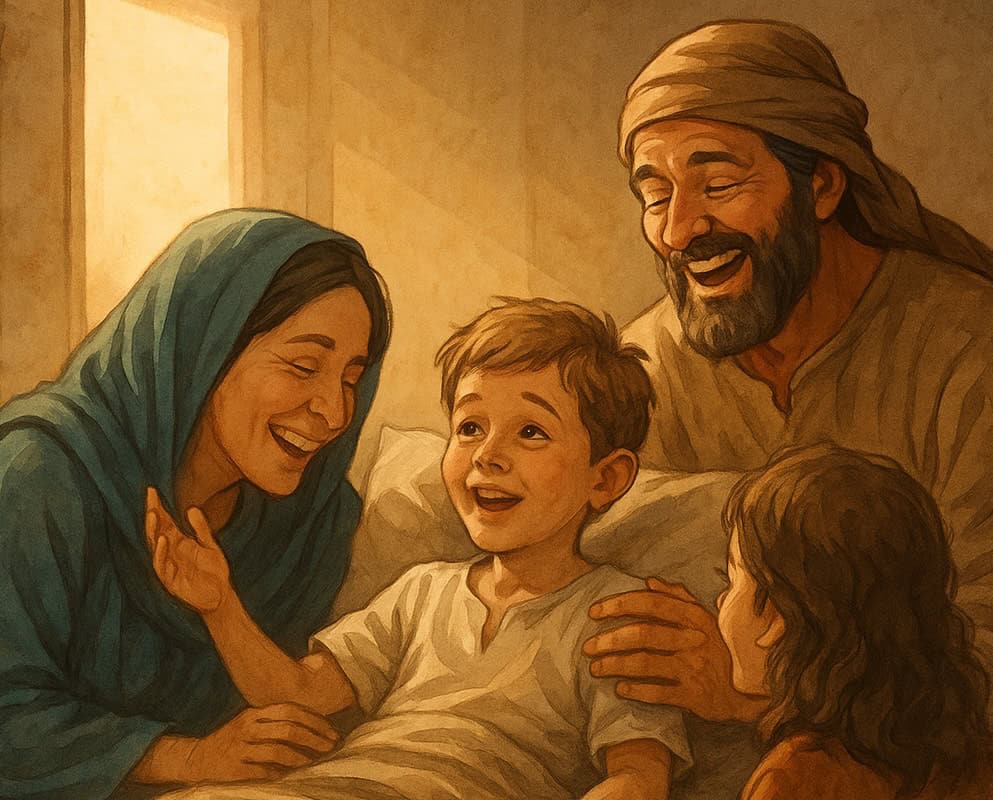When Desperation Becomes a Journey of Faith
The story of Jesus healing the official’s son unfolds quietly in John 4, yet it carries the heartbeat of the Gospel itself.
A father stands at the edge of heartbreak. His son lies dying in Capernaum. Medicine has failed. Hope feels thin. Then he hears a rumor — the Healer has come back to Galilee.
He doesn’t know much. But he knows enough to start walking.
That’s where this story begins — not with certainty, but with movement.
Desperation and Divine Direction
The journey of this father reveals a deep theological truth — God often uses desperation as the doorway to faith. Throughout Scripture, we see that human helplessness becomes the very soil in which divine grace grows. When every other source of help is exhausted, the heart becomes ready to look upward.
The man’s faith begins not with understanding, but with motion. In Greek, the structure of John’s narrative emphasizes continuous action — he was going, not simply went. That’s how faith often looks at the start: uncertain steps sustained by a faint glimmer of hope.
It’s worth noting that Jesus did not begin His ministry among the self-sufficient elite of Jerusalem, but among those desperate enough to seek Him in small Galilean towns. Faith, in its purest form, is not the achievement of knowledge — it is the surrender of self-sufficiency.
This first step of the official mirrors our own: we don’t come to Christ because we’ve mastered theology; we come because we need mercy. As Augustine said, “Faith begins where pride dies.” Every believer, at some point, must walk that uphill road — from human power to divine dependence.
A Prophet Without Honor
After spending two remarkable days in Samaria, where outsiders embraced Him as “the Savior of the world,” Jesus heads north into His home region of Galilee. John inserts a sobering line:
“Now Jesus himself had pointed out that a prophet has no honor in his own country.” (John 4:44)
The people welcome Him — but for the wrong reasons. They’ve seen the miracles in Jerusalem and want the spectacle. Their “belief” rests on signs, not on the Savior.
It’s a subtle warning: proximity to Jesus is not the same as faith in Jesus.
The Danger of Familiarity
This verse strikes at the heart of religious complacency. Jesus’ own countrymen had front-row seats to the revelation of God in human flesh, yet they missed the meaning behind the miracles. In Greek, the word “honor” (timē) implies not merely respect, but recognition of worth. The tragedy is that those who knew Jesus best failed to recognize His true identity.
Here we glimpse the sobering theology of revelation and response: God can be near and yet not known. The light can shine in darkness, but the darkness does not always comprehend it (John 1:5). Familiarity with Jesus’ teachings or church life is never the same as faith in His lordship.
This is why John places this scene right after the Samaritan revival. The Samaritans — despised outsiders — believed without a single miracle. Meanwhile, the Galileans, proud insiders, demanded signs. The contrast is deliberate: God’s kingdom moves not where religious familiarity is deepest, but where hearts are most open.
It challenges every generation of believers. We can quote verses, attend worship, and still fail to give Christ the honor He deserves if we treat Him as useful rather than glorious. The Galileans admired the power of His hand; the Samaritans surrendered to the truth of His word. One group was impressed — the other was transformed.
A Father’s Desperate Plea
In that same region is a man of influence — a royal official, possibly attached to Herod Antipas. Power and wealth couldn’t shield him from the one enemy that respects no title: death.
His son’s fever is spiraling out of control. Someone brings word: “Jesus is in Cana.”
Capernaum to Cana — about twenty miles uphill. But when your child’s life is on the line, distance doesn’t matter. He goes.
When he finds Jesus, his composure breaks.
“Sir, come down before my child dies.” (v. 49)
There’s no pretense in that cry. Just raw, unfiltered desperation.
And Jesus responds with words that sound at first like a rebuke:
“Unless you people see signs and wonders, you will never believe.” (v. 48)
It’s not cruelty — it’s calibration. Jesus is turning the man’s faith from seeing to trusting, from proof to promise.
A Father’s Desperate Plea
Here the scene shifts from crowds to one man — a father crushed by the weight of impending loss. In this brief encounter, the Gospel reveals one of its tenderest truths: faith often begins in desperation.
This royal official isn’t coming with perfect theology. He doesn’t yet grasp Jesus as the incarnate Son of God. But he comes with something God always honors — humility and need. His journey from Capernaum to Cana mirrors the journey of faith: uphill, uncertain, fueled by hope more than understanding.
When Jesus says, “Unless you people see signs and wonders, you will never believe,” He’s not scolding this man alone. The “you” is plural — aimed at the watching crowd. Jesus is drawing a line between curiosity and conviction. He desires belief not built on spectacle, but on the authority of His word.
In that moment, the man stands at a crossroads. Will he insist on seeing before believing, or will he take Jesus at His word and go home trusting that what was spoken is already done? That is where faith matures — when we cling not to emotion or evidence, but to the character of the One who speaks.
This is not a story of instant triumph; it’s a story of faith that learns to walk. The official begins with a request for Jesus to come down (v.49), but ends walking back home with confidence that Jesus’ word alone is enough.
Faith That Takes Him at His Word
Then Jesus says something astonishingly brief:
“Go,” Jesus replied, “your son will live.” (v. 50)
No touch. No journey back to the bedside. Just a word.
Here is the pivot point of the entire passage:
“The man took Jesus at His word and departed.”
That single sentence is one of the purest pictures of faith in the Bible.
He doesn’t argue. Doesn’t beg for proof. Doesn’t demand a sign.
He simply believes the Word — and starts walking.
Imagine that road home. Every mile is a wrestling match between faith and fear. Every step asks the same question: “Can I really trust what He said?”
But faith walks anyway.
Faith Rooted in the Word
The official’s response gives us a profound definition of biblical faith: trusting God enough to act on His word before you see the outcome.
In Greek, the phrase “took Jesus at His word” (literally episteusen tō logō) uses the same verb — pisteuō — that John employs throughout his Gospel to describe saving belief. It’s not a shallow optimism or hopeful wishing; it’s confidence in the reliability of what Jesus has spoken.
This moment captures the heart of sola fide — salvation and transformation through faith alone. The man doesn’t need a sign, ritual, or proof. His belief itself becomes the vessel through which grace flows. The power is not in his believing, but in the One he believes in.
John intentionally builds this scene around Jesus’ spoken logos — His word. Just as creation was formed by divine speech (“Let there be light”), new life now springs from the same authority. The official’s son lives because the eternal Word spoke life once again. In this, the story subtly echoes the prologue of John: “In Him was life, and that life was the light of all mankind.”
Theologically, this section dismantles any notion that faith must be accompanied by visible signs to be real. Jesus is forming in this man — and in us — a faith that can survive in the silence between promise and fulfillment.
True faith is not proven when we see the miracle, but when we keep walking without it.
When the father turned toward home, his faith graduated from desperation to dependence. He no longer clings to Jesus’ physical presence, but to His spoken promise. That’s where mature belief begins — when we trust that the Word of God is as powerful as His presence.
The Miracle Confirmed
While he’s still on the way, his servants appear on the horizon, running toward him. Their faces tell the story before they speak:
“Your boy is alive!”
He asks when the fever broke.
“Yesterday, at one in the afternoon.”
And the father realizes — that was the exact moment Jesus said, “Your son will live.”
No delay. No distance. Just divine authority.
At that realization, Scripture says:
“He and his whole household believed.” (v. 53)
The miracle that began in one man’s crisis now blossoms into a family’s salvation.
Faith Verified, Not Dependent
This passage reveals one of the most beautiful theological truths in the Gospel of John: the word of Christ does not wait for time or space to cooperate. His authority is immediate. What He declares is not merely a wish — it is reality spoken into existence.
When the official hears that the healing occurred “at the same hour” Jesus spoke, the Greek text emphasizes precision — ekeinē tē hōra — “that exact hour.” John wants us to see the perfect alignment between Jesus’ word and the result. There is no lag in divine power. The moment Christ speaks, reality obeys.
But notice something profound: the man’s faith preceded the confirmation. The miracle did not produce belief; it confirmed it. His faith was real the moment he took Jesus at His word. The healing became a visible testimony of what had already happened invisibly — trust in the unseen.
This pattern echoes throughout Scripture. Noah built before the rain. Abraham walked before he saw the land. The disciples cast their nets before the catch. Faith acts first — the evidence follows.
And the fruit of faith is always multiplication. The text says, “He and his whole household believed.” In the first-century world, that phrase would mean everyone under his roof — family, servants, possibly extended kin. One man’s obedience rippled through an entire household. The same God who healed his son also awakened their hearts.
Theologically, this moment captures what the Gospel of John calls “signs.” They’re not random acts of compassion; they are revelations of who Jesus is — the life-giver, the Word made flesh, the Lord whose authority transcends sickness, distance, and time.
Every miracle in John’s Gospel is meant to do what this one did — lead to belief that transforms entire households.
Faith Without Seeing
John tells us this was the second sign Jesus performed in Galilee.
The first, turning water into wine, revealed His power to transform.
The second reveals His power to heal — not just bodies, but hearts hardened by doubt.
It’s easy to believe when the evidence is in your hands.
It’s harder when all you have is a word spoken from a Galilean hillside two thousand years ago.
Yet that’s the essence of Christian faith.
“Blessed are those who have not seen and yet have believed.” (John 20:29)
The official believed before he saw. And through his obedience, his family came to know the Savior personally.
That’s why John includes this miracle — to show us that genuine belief rests not on what we can verify, but on the trustworthiness of the One who speaks.
Seeing Through the Word
The healing of the official’s son brings John’s early “sign narratives” full circle. The first sign at Cana (John 2) revealed Jesus’ creative authority — the power to bring joy and newness where emptiness once was. The second sign at Cana reveals His sovereign authority — the power to restore life where death was already assumed. Both point to His identity as the Word made flesh, whose command shapes reality itself.
In the Greek text, the word for “sign” (sēmeion) means more than miracle — it means a marker that points beyond itself. The healing is not the focus; the Healer is. John structures his Gospel around seven such signs, each unveiling a deeper aspect of Jesus’ divine nature. This second sign in Galilee reveals that His power doesn’t depend on visibility or nearness — He rules over distance, disease, and doubt alike.
Theologically, this story answers one of the central questions of Christian life: What sustains faith when God feels far away?
The royal official teaches us that faith is not the opposite of doubt — it’s obedience in the midst of it. He didn’t need to understand how Jesus’ word could transcend twenty miles of separation. He simply trusted that the One who spoke the universe into being could speak life into his son.
John’s Gospel closes with Jesus’ words to Thomas: “Blessed are those who have not seen and yet have believed.” That blessing is extended to every believer who has ever trusted the Word of Christ without seeing His face. We stand in the same lineage of faith as this royal official — those who walk by faith, not by sight.
When Jesus Speaks Into Our Fear
We all face moments when the distance between God’s promise and our pain feels unbearable.
A doctor gives a diagnosis that shakes you.
A prodigal child seems beyond reach.
A prayer goes unanswered for months or years.
And yet, the same Jesus who healed that boy still speaks today:
“Go — your son will live.”
“Go — your heart will heal.”
“Go — I am already working.”
Faith is the courage to walk home on those words before you see the results.
Reflection: The Word That Still Heals
This final note draws the story of John 4 to its spiritual summit. What began as a father’s plea ends as a portrait of how God’s word penetrates human fear. The miracle in Cana was not simply an isolated act of compassion — it was a living parable of how faith functions in a fallen world.
The royal official teaches us that fear is not the enemy of faith; it is often the soil in which faith grows. His journey between Cana and Capernaum mirrors the path many believers walk between promise and fulfillment. Theologically, it shows us that faith doesn’t remove fear — it redeems it. Every trembling step home was an act of trust that God’s word was more reliable than his emotions.
When Jesus said, “Go, your son lives,” He didn’t just heal a body; He re-ordered a heart. That same Word continues to work in us. The Greek verb zaō (“lives”) is present and ongoing — suggesting that the life Jesus imparts is not confined to one moment in history but continues to pulse wherever His Word is received in faith.
This is the heartbeat of the Gospel: Christ still speaks life where death has taken hold. His Word still heals what is broken, still calls the lost home, still silences fear with truth.
So when you cannot see the outcome, remember this scene in John 4.
You may still be walking the road between promise and fulfillment, but the miracle may already be in motion.
The Slow Miracle of Trust
Notice: the father’s faith didn’t spring fully formed. It grew.
- It began in desperation — “Come heal my son.”
- It deepened through obedience — “Go, your son will live.”
- It matured into confidence — “He and his household believed.”
That’s how faith still grows.
Every answered prayer strengthens it.
Every delay stretches it.
Every disappointment refines it.
Faith isn’t the absence of doubt — it’s the decision to keep walking when sight fails.
The Word That Still Heals
John structures his Gospel around seven signs — each one pointing to who Jesus is. But the signs aren’t the point; the Savior is.
The royal official’s story shows that Jesus heals by His word alone. His authority transcends space and circumstance. He doesn’t need to be physically present to act.
That truth changes how we pray.
When you open Scripture and read His promises, you’re not reading empty comfort — you’re hearing the same authoritative voice that once said, “Your son will live.”
The same power that healed a child in Capernaum now works in unseen ways across the miles, across time, across every barrier of fear.
From Crisis to Testimony
The man went home expecting to find a miracle — and he did. But more importantly, he found the Miracle-Worker worthy of lifelong trust.
And like the Samaritan woman before him, he couldn’t keep it to himself. His whole household believed. Faith is contagious when people see its fruit.
You may never stand before Jesus in person, but every step of obedience writes your own testimony: “He spoke, and I believed — and He proved faithful.”
When Faith Walks Without Sight
Perhaps today your “Capernaum” is a situation beyond your reach — a relationship you can’t fix, a body you can’t heal, a future you can’t control.
You’ve prayed, pleaded, and perhaps wept.
And still, Jesus whispers the same words:
“Go… your son will live.”
Go on trusting.
Go on praying.
Go on walking in faith that listens more than it looks.
Because the One who speaks the word is faithful.
Reflection Verses
- Hebrews 11:1 — “Now faith is confidence in what we hope for and assurance about what we do not see.”
- Romans 10:17 — “Faith comes from hearing, and hearing by the word of Christ.”
- John 20:29 — “Blessed are those who have not seen and yet have believed.”
Closing Thought
When Jesus heals the official’s son, He’s doing far more than saving a child. He’s revealing a pattern for every believer who must trust Him in the gap between promise and fulfillment.
Faith isn’t passive — it walks, even when the road home feels long.
It listens, even when silence lingers.
It believes, because Jesus’ word is enough.So keep walking. The miracle may already be in motion.





Leave a Reply